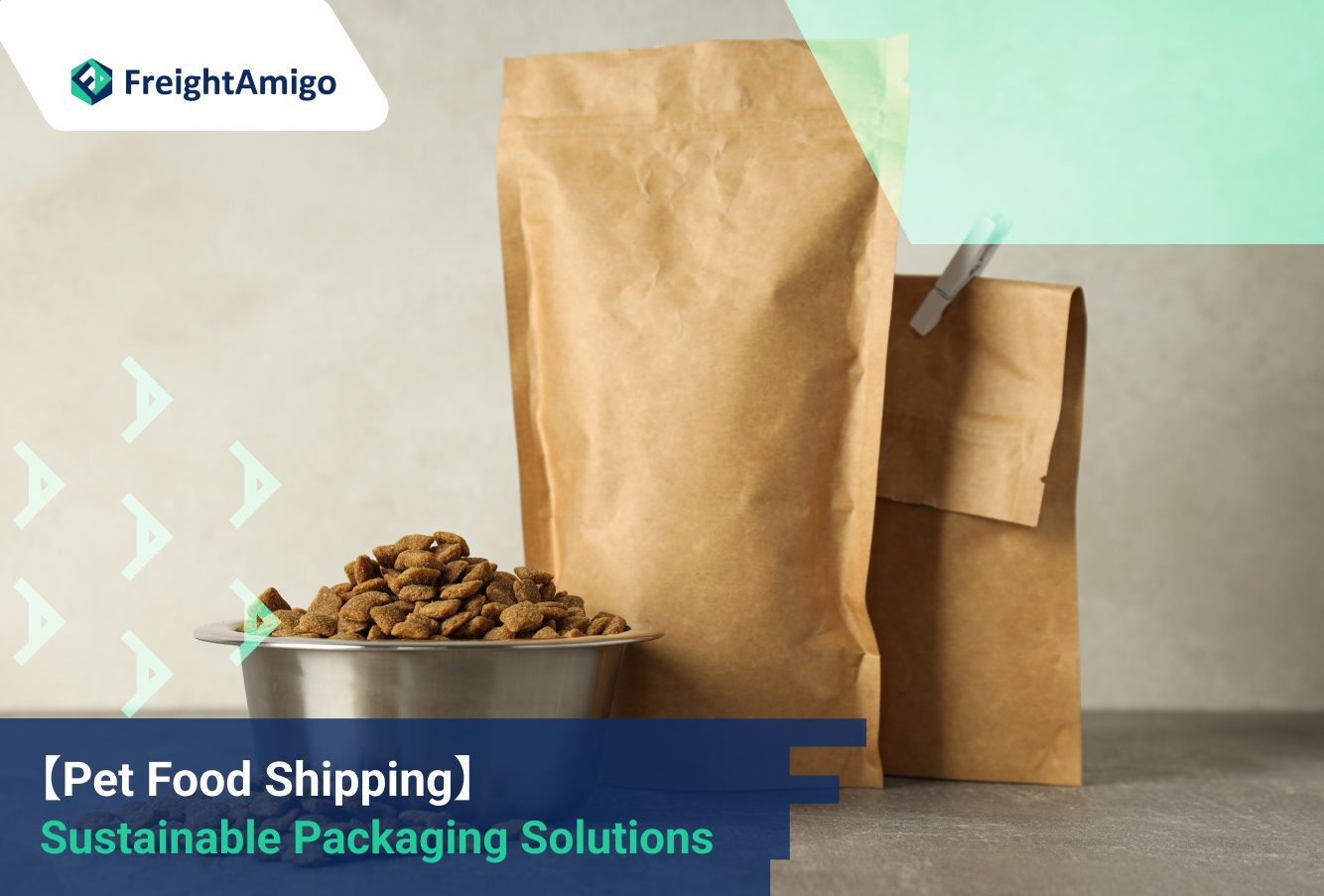In today’s world, sustainability has become a top priority for consumers, including pet parents. As pet owners become more environmentally conscious, they are increasingly concerned about the impact of the products they purchase, including how they are packaged. This has led to a growing demand for sustainable packaging solutions in the pet food industry. In this article, we will explore several eco-friendly packaging options for pet food shipping, including biodegradable materials, recyclable packaging, and innovative designs that reduce waste and environmental impact.
Latest update on 7 March, 2024 by Aurora Park – Marketing Analyst at FreightAmigo
Want to compare the best Express, Air Freight, Sea Freight, Rail Freight & Trucking rates so as to have better control on cost?
The Importance of Sustainable Packaging
The pet food industry, like many others, has recognized the importance of sustainable packaging. Packaging plays a critical role in protecting the shelf life and taste characteristics of pet food products. However, traditional packaging materials, such as plastic, can have a negative impact on the environment. Therefore, it is essential to adopt sustainable packaging practices to minimize waste generation, promote recyclability and reduce the industry’s overall environmental footprint.
In addition, today’s consumers are increasingly environmentally conscious. They actively seek out products that align with their values, including environmentally friendly packaging. By adopting sustainable packaging solutions, pet food brands can enhance their brand image, attract a broader customer base and build loyalty among environmentally conscious consumers.
In addition, regulatory bodies and governments are placing greater emphasis on environmental regulations. Meeting these evolving standards by adopting sustainable packaging can help the pet food industry stay compliant and minimize the risk of legal challenges. It also ensures the long-term viability and sustainability of the industry as a whole.
Biodegradable Materials for Pet Food Packaging
One of the key aspects of sustainable packaging is the use of biodegradable materials. Biodegradable materials are designed to break down harmlessly in various environments, reducing the persistence of packaging waste. They offer a promising alternative to traditional plastics, which can have long-term negative effects on the environment.
Several advances have been made in the development of biodegradable materials for pet food packaging. For example, researchers are exploring alternatives to petroleum-based plastics that are not only sustainable, but also economically viable and scalable for large-scale production. These materials aim to significantly reduce the environmental impact of pet food packaging.
Circular Economy Models for Packaging
Adopting circular economy principles is another important aspect of sustainable packaging. Circular economy models focus on designing packaging that can be easily recycled, reused or repurposed. By creating packaging systems that seamlessly integrate into circular supply chains, the need for new raw materials is minimized, further reducing environmental impact.
In line with circular economy models, the pet food industry is moving towards recyclable mono-material packaging. This type of packaging is made from a single material, making it easier to recycle. Post-consumer recycled material (PCR) and renewable resins are also gaining momentum in the industry, offering more sustainable alternatives to traditional packaging materials.
The Rise of Compostable Packaging
Compostable packaging is another environmentally friendly option gaining popularity in the pet food industry. Compostable packaging is designed to break down into natural elements in a composting environment, leaving no harmful residue behind. This type of packaging offers a sustainable and environmentally friendly solution for shipping pet food.
However, it is important to note that compostable packaging requires specific conditions to decompose properly. It is critical for consumers and pet food brands to understand the composting process and ensure that compostable packaging is disposed of properly to maximize its environmental benefits.
Smart Packaging for Sustainability
The integration of technology into packaging has opened up new possibilities for sustainability. Smart packaging refers to packaging that incorporates sensors or indicators to improve sustainability. For example, sensors can be used to monitor product freshness to reduce food waste. Indicators can also help consumers make informed decisions about recycling or disposal.
By leveraging technology, smart packaging can contribute to a more sustainable pet food industry. It enables better tracking of environmental impacts, enhances product safety and provides consumers with valuable information about the sustainability of the packaging and the product itself.
Reducing Packaging Weight and Volume
Innovations in materials and design have resulted in packaging that is lightweight yet strong. Reducing the weight and volume of packaging can have a significant impact on the environment by reducing energy consumption during transportation and storage. By using lightweight materials and optimizing packaging design, pet food brands can minimize their carbon footprint and contribute to energy savings.
Innovative Recycling Technologies
Advances in recycling technologies are essential to achieving a more sustainable pet food industry. Chemical recycling and improved sorting processes can increase the efficiency of recycling systems. This allows for a wider range of materials to be recycled, reducing the amount of packaging that ends up in landfills.
The pet food industry is actively researching innovative recycling technologies to improve the sustainability of packaging. By investing in these technologies, pet food brands can contribute to a circular economy where packaging materials are continuously reused or repurposed.
Consumer Education and Awareness
While sustainable packaging solutions are essential, consumer education and awareness play an important role in driving demand for environmentally friendly options. It is critical to educate consumers about the environmental benefits of sustainable packaging and to encourage behaviors that support recycling and responsible disposal.
Clear labeling and transparent communication about the environmental attributes of pet food packaging can help consumers make informed choices. Providing information about packaging materials, recycling instructions and the overall sustainability efforts of pet food brands can empower consumers to make environmentally conscious decisions.
Conclusion
Sustainable packaging solutions are becoming increasingly important in the pet food industry. By using biodegradable materials, embracing circular economy models, and leveraging innovative design and technology, pet food brands can reduce their environmental impact and meet the growing demand for eco-friendly packaging.
However, it is critical that pet food brands avoid greenwashing – making false or misleading claims about the environmental benefits of their packaging. Transparent communication, backed by evidence and data, is essential to build trust with environmentally conscious consumers.
By focusing on sustainable packaging, the pet food industry can contribute to a healthier planet and meet the evolving demands of pet parents who prioritize both the well-being of their pets and the environment. By choosing sustainable packaging options, pet food brands can demonstrate their commitment to a more sustainable future.
There are different options for cargo transportation. If you want to choose the most convenient and suitable solution, it is best to have the full support of logistics experts! If you are planning to import Pet Food, please go to the FreightAmigo page for inquiries.
If you have any inquiries on logistics/supply chain, feel free to contact FreightAmigo now:
Chat with us online | Hotline: +852 28121686 | WhatsApp: +852 27467829









































